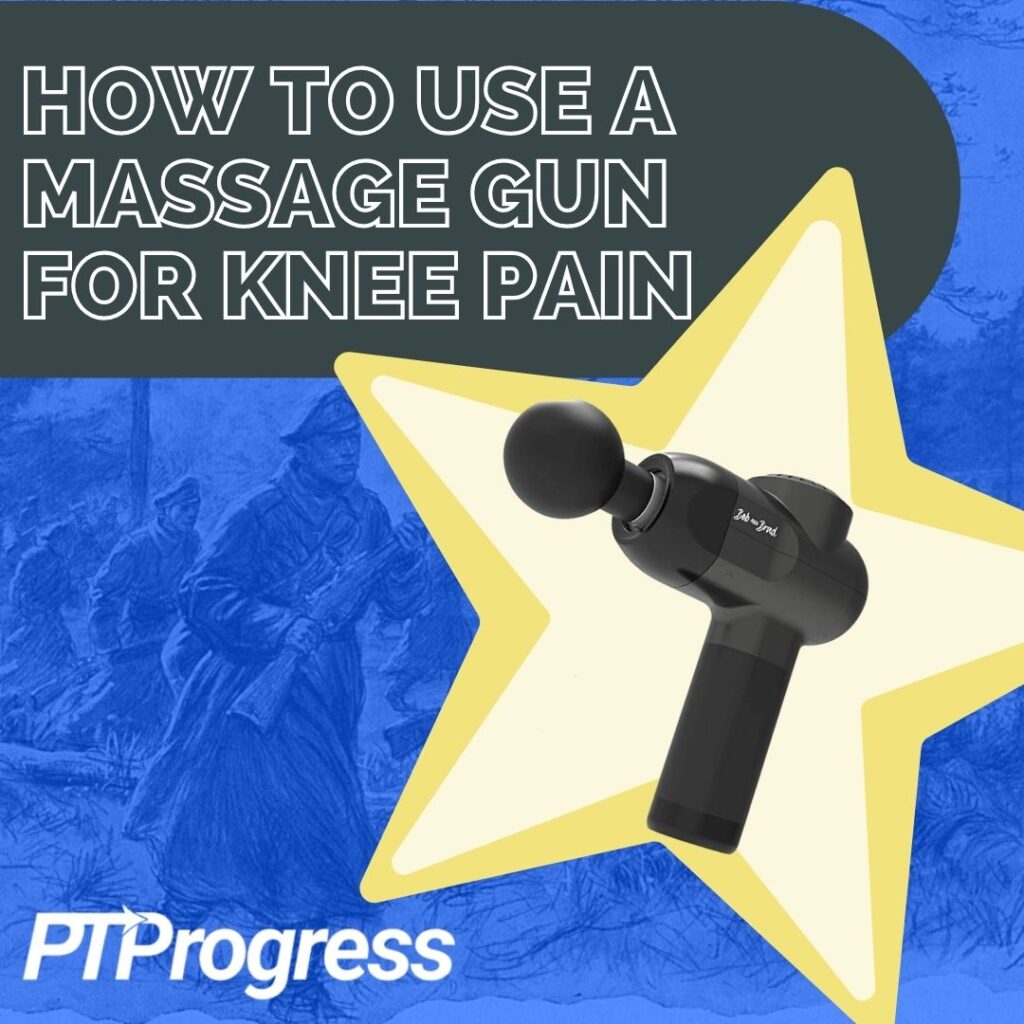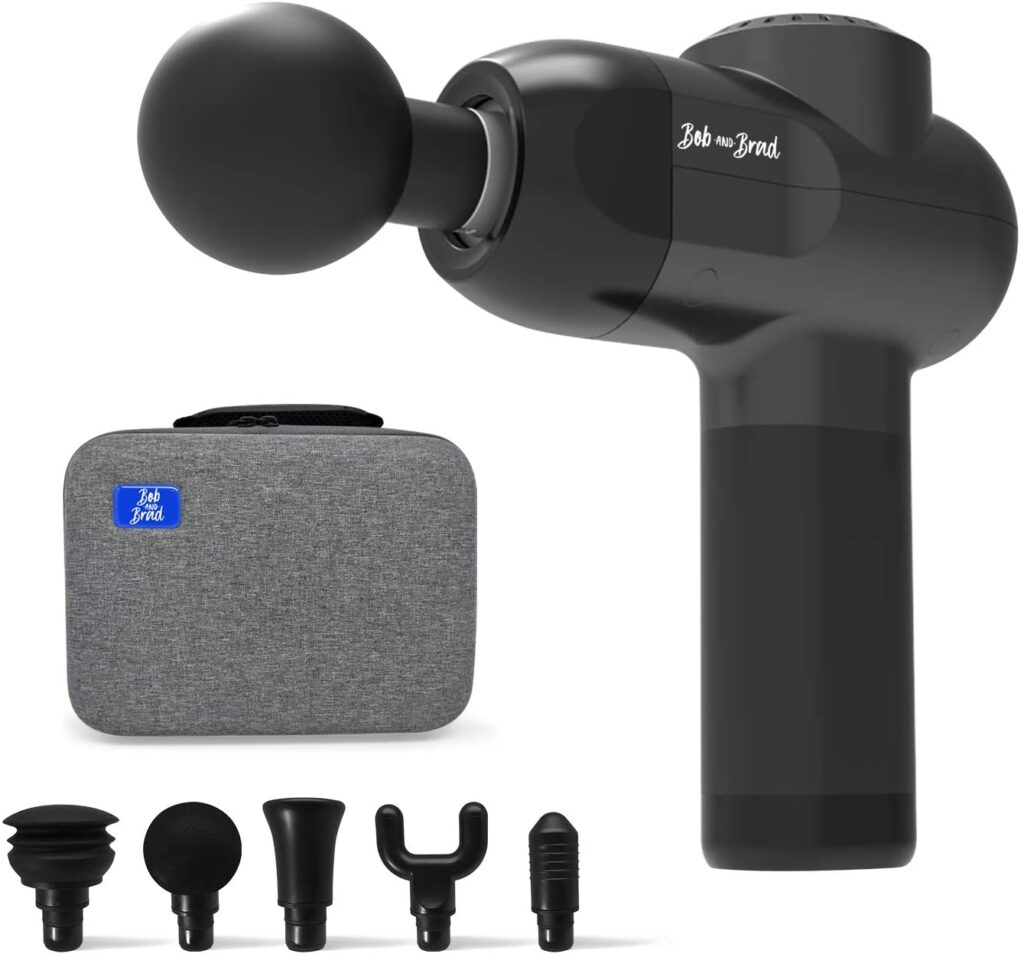
Are you experiencing knee pain right now? If you have a massage gun, you’re in luck. There aren’t many true “quick fixes” in life, but you can get fast relief from knee pain using a massage gun. Below I’ll share 3 tips for getting the most out of your massage gun treatment.
Knee Pain: A Common Complaint
Have you ever been minding your own business – maybe working in your garden or playing with your dog – when all of a sudden your knee declares war on the rest of your body? Whether it’s a sudden onset or a chronic condition, knee pain is hard to shake.
But knee pain is extremely common. We use our knees for everything, from walking to sitting to jumping, and everything in between.
And, because knee pain is so pervasive, it can affect anyone, regardless of age or activity level. I see all kinds of patients in the physical therapy clinic, many who want to get rid of knee pain fast.
If that’s you, keep reading for some tips on using a massage gun for knee pain. But first, let’s consider what knee pain actually is, and how to treat it.
What is Knee Pain, Exactly?
The technical term for knee pain is “patellofemoral” pain, but don’t expect a textbook term to give you a textbook definition. Knee pain varies widely, including location (where it hurts), duration (how long it hurts after activities) and what’s actually causing the pain.
Causes of knee pain can be ambiguous because the knee is a major juncture in your body. Postural misalignments, from your hip to your toes, can create a domino effect that instigates or worsens knee pain.
There are also chronic conditions, such as arthritis or fibromyalgia, that manifest as knee pain. Other times, you might experience pain from a sudden injury or as you recover from a major surgery.
Whatever the reason for the irritation, swelling or pain, the result is limited functional mobility, even with simple movements such as squatting, walking or going up and down your stairs.
How to Treat Knee Pain
Although your knee pain may culminate right there at the knee – whether it’s the front, back, or side – it’s best treated by targeting the muscles that connect to the knee, both above and below.
A strained or overworked muscle is a major contributor to knee pain. And your knee is affected by many of them: hamstrings, adductors, quadriceps, and calf muscles all connect to the knee. So, while massaging the knee might not actually help your knee pain, massaging the nearby muscle groups will!
So grab your massage gun, and let’s knock out your knee pain!
Using a Massage Gun for Knee Pain
Everything I mention in this article will work regardless of the type of massage gun you have. However, I use and recommend the Bob & Brad C2 Massage Gun and the Bob & Brad Mini Massage Gun. You can read more about each of these guns, and others like them, in this post.

A massage gun uses percussive force to simulate a deep tissue massage, which is exactly what your tight quadriceps are asking for right now. This kind of force brings a host of benefits to your muscles and joints.
Using a massage gun helps improve blood flow, promote tissue healing, encourage better muscle recovery, and thus relieve pain.
That being said, a massage gun is not a silver bullet for curing arthritis, fixing a damaged meniscus, or substituting a healthy lifestyle of regular stretching and exercise.
But if your knee pain is due to strained muscle groups or postural imbalances, a massage gun will relax those muscles and relieve strained tissues, reducing your knee pain.
Below are 3 tips to keep in mind when using your massage gun for knee pain.
Tip #1: Target the muscles around the knee
Because a massage gun works best on muscles – not painful joints – you’ll get the right results by targeting muscle groups that surround the knee. Don’t just set your massage gun to the hightest setting, aim for the kneecap, and pull the trigger. Ouch.
Source: clipstudio.net
Where to use your massage gun for knee pain:
- Quadriceps: the long muscles in the front of your thigh
- Adductors: the muscles in your inner thigh
- Hamstrings: the large muscle group in the back of your thigh
- Calf muscles: the fleshy part of your inner, lower leg, towards the back
What direction to use your massage gun:
- Along the muscle itself – lengthwise, from top to bottom
- In a circular motion within the muscle group
- Cross-ways, perpendicular to the muscle
How long to use your massage gun:
If you’re still getting used to your massage gun, shoot for at least 15-30 seconds of sustained massage per muscle group. Ultimately, 2-3 minutes is an ideal amount of time.
I recommend changing it up, too. You can hit your quads for 30 seconds, then move around to your hamstrings before finishing up the quads. Just be sure to give each area sufficient time to respond to the massage.
The bottom line is to massage in a way that is comfortable to you. Repeat this treatment a couple of times each day you experience knee pain.
Tip #2: Exercise!
I know, I know – you’re in pain. You have a good excuse to stay glued to the couch. But your pain won’t go away if you do nothing. Make sure you’re still exercising these muscles one way or another despite your knee pain.
Maybe you’re worried that exercising will make your knee pain worse. That all depends on what you’re doing! I always give my patients exercise activities that won’t provoke the knee, so that they can reap the benefits of exercise without worsened pain. Low-impact activities, such as walking or swimming, are easy on the knees but great for promoting blood flow.
Using your massage gun while exercising
But you can also use your massage gun to help ease your knee pain as you exercise (so long as you’re not in a pool!). Administer massage before, during, and after a workout to get through your movements with less pain.
During a workout:
For example, if I feel pain in my knee from doing squats, I’ll turn on my massage gun and target my quadriceps as I squat, running down the length of the muscle as it’s engaged in the movement. Most of the time, this strategy takes care of the pain right away.
Before a workout:
If you remember from PE class, warm-up exercises function to increase blood flow to your muscles and prevent injury later. A massage gun has a similar effect on your muscles, warming them up before a rigorous workout and helping you avoid a strain.
After a workout:
There’s nothing like a deep, percussive massage for recovering tight, sore muscles after a workout.
As you stretch or move your muscles:
Finally, throughout the day as you move about, pay attention to when you feel pain. Does it shoot through the back of your knee whenever you stand up or extend your leg? That means your hamstring might be tight.
Try massaging your hamstring as you extend your leg while seated:
- Keep your gun on the lightest setting and massage the hamstring as you bend and extend your leg in whatever range of motion the pain allows. You may find that, after a few minutes, this takes care of the issue and you can stand up without pain.
You can repeat this same concept with other muscle groups, such as your quads or calf muscles. All told, these muscles don’t need to be in a relaxed state to benefit from the massage. And by massaging them as you move and flex, you might get faster relief from your knee pain.
Tip #4: Experiment with Attachments
Most massage guns come with an array of attachments or interchangeable heads. This video demonstrates the ones that came with my Bob & Brad guns. However, in general, I encourage you to get acquainted with your massage gun heads. You might have a go-to attachment, but experimenting with the others might help you find faster relief for your knee pain.
For example, some of my massage gun heads offer more pinpointed percussion for bullet-like precision. Others soften the blow and disperse it over a wider area.
Perhaps my favorite attachment for knee pain is the ball, which is perfect for achieving a light, cross-friction massage.
With this attachment, I can get closer to my knee pain and even massage the tendons near my patellar joint.
If you have an attachment like this, try it out for yourself. Instead of hitting the muscle group head-on, turn the gun to the side and let the edge of the gun head pulsate across your leg. This modifies the massage quite a bit, and is perfect for more sensitive areas.
No matter which attachments you use, a good plan is to follow up your massage treatment with 15-20 minutes of ice and elevation. Place the ice pack directly over your knee to reduce any lingering pain, and elevate your leg to draw out any fluid or swelling.
Bonus Tip: Drink lots of water
Speaking of fluid, muscles are 80% water! If you aren’t staying hydrated throughout the day, your massage gun treatments won’t do much good. Water is essential to repairing tissue, flushing out lactic acid and promoting healing in the body.
Summary
When waging the war against knee pain, a massage gun is a worthwhile weapon. By targeting muscle groups, using movement, and experimenting with different attachments, you’ll make great strides towards reducing your knee pain.
However, the best way to eradicate knee pain for good is to strengthen and stabilize any overworked muscles contributing to the pain. Check out this article for 3 simple exercises you can include in your daily routine to stabilize your knee and prevent pain.
Finally, if you’re looking to buy a massage gun – or upgrade the one you have – here’s a coupon for 10% off the Bob & Brad Massage Gun I use. Use coupon code “PTProgress10” on Amazon.

